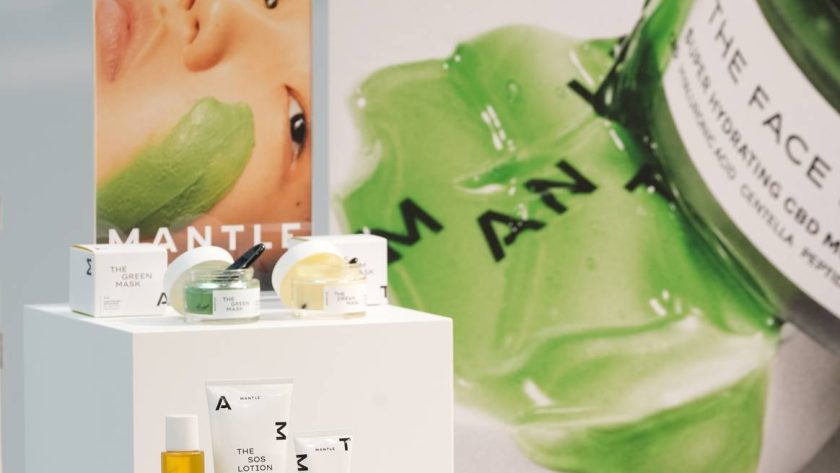Beauty is a market that, according to a study at McKinsey & Company, is expected to reach approximately 580 billion dollars by 2027. So it is not surprising that fashion has begun to take notice of this lucrative, yet stable industry, as it no longer simply tests the waters but instead makes a definitive splash in a bid to scoop up market share.
Evidence of this can already be found at fashion trade shows, where beauty has become an area of interest and slowly introduced as a new category. This is especially true for the Copenhagen International Fashion Fair (CIFF) – taking place between August 9 and 11 – which has been a leader in pushing the beauty market in the already established trade show space.
This year was the first in which beauty became a permanent fixture for the event, initially introduced as part of the show in February with this season now offering a much wider selection. For the SS24 show, some 20 beauty brands participated, all located in CIFF’s ‘Blanc’ hall entirely dedicated to the category, just off the main fashion-focused sections. To present their products, most brands here each stuck to a minimalist theme, with stands that were typically cleancut in presentation reflecting their approach to production.
Why beauty and why now?
While attending CIFF, FashionUnited took an interest in fashion’s increased inclusion and growing interest in the sector. Speaking to some of this year’s participants, it was clear that this observation was mutual. Woods Copenhagen, which used this year as an opportunity to reach new markets and build on brand awareness, recognised fashion’s desire to expand in this area. Maria Dupont Simonsen, sales executive for the brand, told FashionUnited: “(Beauty) is growing, it’s where the money is. (Trade shows) have been trying to avoid it for so long, but it’s a very big category. Lots of lifestyle shops are starting to take beauty into account to make a more holistic offering, to make it a whole category instead of picking just one brand, which is what retailers have normally done.”
Meanwhile, at Bodyologist, a brand founded in 2021 and attending CIFF for the second time, co-founder Charlotte Winther Nørlev also saw an opportunity for both fashion and beauty in the latter’s attendance. Nørlev noted: “We see a lot of natural synergies between the two categories. It’s often the same client, the same target group. Also, when you are making a floor plan for a department store, you often put accessories, lingerie and beauty in an accessible area, as they are a nice opening for clients coming in to then lead up to fashion on the next levels of the store.”
As mentioned, the beauty industry in itself is also currently booming. Likely triggered by the pandemic, during which time society intentionally slowed down and became more considerate, an influx of new, young skincare brands have descended on the market. This was obvious among the attendees of CIFF, many of which, like Bodyologist, emerged within recent years with a fresh perspective on what beauty stands for. It has made mature players like Raaw Alchemy hyper aware of the environment they are operating in and the rising competition.
Founder and owner of the brand Trice Angie Christiansen was the first from the sector to be included in the CIFF roster, having now been present at the show for eight years. While initially focused on brand awareness and concept stores, Christiansen recently finds herself drawing in bigger accounts from department stores to international boutiques, with CIFF being a cost-effective solution to communicate with such clients.
She added on the market as a whole: “Sales in beauty are definitely on the rise. Other stores are also trying to think differently, figuring out how to sell smaller products that are not as costly as fashion items while also attracting different clients through new price points, without compromising quality. They can keep their high-end brands, but they can also attract other clients with cheaper products. It’s definitely the industry to be stepping into, but it’s also tougher now because there’s so many (brands). You just have to be really on top of your game.”
Sustainability ingrained into the seams, fashion take notes
Previously placed among the fashion brands, Raaw’s lengthy involvement in the event has given Christiansen a good overview of the dynamics in both sectors. Now sitting among her own kind, Christiansen noted one of the significant contrasts she could see: “I really feel a change in the attitude between beauty brands and fashion brands. It’s a different pace. Beauty is slower, and about taking your time. Fashion is so fast. (Fashion exhibitors) were always nice to me because I’m not their competitor, but I could definitely feel a competitive vibe there, which can be motivating, but in beauty people are helping each other out and sharing insights or buyers.”
There is also no talking about the difference between beauty and fashion without highlighting the contrasting approach to sustainability. When asked what she saw as beauty’s advantage, Olga Bogdal, the founder of three-year-old brand Bogna Skin, said it was in “the communication of your brand, the story behind it and the customer’s awareness of ingredients and materials”. She added: “Both branches are intensely working on sustainability, but for fashion, they first think about sustainability, then they create the product based on the materials. In our case, we only choose ingredients that are safe for the environment and then create a formula that is effective and brings the right results.”
In fact, for the participating beauty brands as a whole, sustainability was a clear value that wasn’t just a consideration or a choice, but something ingrained into the fibres of their being. Since its inception, such qualities have been at the core of Bodylologist, for example. The brand’s Nørlev commented: “The beauty industry is more invested in the environment, and making the right decisions – trying to make sure that you are cleaning up your mess – where I think fashion is starting to just pick up on those ways of thinking. The beauty industry is a bit further ahead. Our packaging and products are of course a different category, but I think the mindset is something that we can learn from each other.”
Where can this inclusion of beauty go?
For many, attending CIFF was a first when it came to trade shows overall. Others, meanwhile, were more familiar with beauty-centric events that are renowned in that industry, such as Cosmoprof in Bologna or Olympia in London. While interest in taking part in such events has of course not waned, this interest in CIFF has encouraged beauty brands to consider beyond the markets they already have a firm place in. Yet, with beauty being a whole other ball game compared to that of fashion, there are also differing elements to consider in order to truly uplift the market. CIFF’s efforts to push the category could already be seen, with the show’s director Sofie Dolva regularly taking potential buyers on a tour of the section and new signs placed each day to encourage more traffic.
Really though, many of these brands are simply seeking retailers that already have some expertise on cosmetics and skincare. While general partners such as department stores and e-tailers are of course welcome, it is niche boutiques and concept stores that have some familiarity with the sector that exhibitors are particularly drawn to. This was true for the likes of Bodyologist and Bogna Skin, both of whom offer products with active or complex ingredient combinations that require stockists to act more as educational and informative touchbases for the end consumer. Bodylogist’s Nørlev noted: “It is very important that (clients) have the right skills to teach and educate the consumers about how to use (our products). It’s important then that they have some sort of background in skincare.”
It is additionally imperative to consider the differences between fashion and beauty when engaging and establishing a rapport with exhibitors. Those planning on attending CIFF next season are also hoping to be more intertwined with the fashion categories to create a better flow of clients and wider visibility. Woods’ Simonsen highlighted: “When it comes to clothing and brands, there are new seasons, new colours, new everything. For beauty, maybe we change packaging or launch new products, but the whole story will remain the same for every fair. To make it more interesting for us to keep attending, we will need support from CIFF or other fairs to make the space even more appealing. Things like talks really attract a lot of people, because they allow us to tell a story and introduce the category.”
At Woods, sights were set on market expansion, something Simonsen feels could be further evident at the trade show in the near-future. Referencing past editions of CIFF, Simonsen noted: “The accessories department has now been spread out to become a part of the fashion fair, and I think (beauty) will be the new ‘accessory’. This department will only grow. It’s only the second time showing, so it’s still developing. I think in five years, it will be a whole hall in itself. I hope we can be more mixed into fashion. Most people that attend are here for that, so when they have a little leftover in the budget they come to beauty. It would be nice to be more central, because we are just a subcategory for what (clients) are actually here for.”
CIFF’s location is also ideal for younger brands that don’t have the logistics or funding to attend fairs outside of the country, yet still want to speak to international buyers. This point was highlighted by Inuacare’s COO, Nanna Louise Haagen Olesen, who added that the brand’s mission was to establish strategic partnerships across borders, particularly with premium retailers. She continued: “CIFF provides us with an opportunity to meet some of these retailers. As a small brand, you sometimes have limited resources, so you really have to prioritise. This is a great opportunity to have everyone see, feel and touch your brand, and also to just tell your story.”
One thing is certain, however, beauty brands are eyeing a wider involvement in similar events as they also look to expand their reach. Bogna, for example, is looking towards the UK market and potentially participating in shows there. The company’s founder said: “It’s important to meet people in person, and right now (these shows) are happening online. I’m a scientist, I’m an architect, so it’s important to get to know the people and share the essence of the brand with them. It’s much easier for us in person. You can feel their energy and if someone gets your brand. I think there should be more events like this.”



